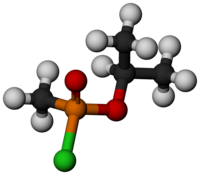Chlorosarin
 | |
 | |
| Names | |
|---|---|
| Preferred IUPAC name Propan-2-yl methylphosphonochloridate | |
| Other names O-Isopropyl methylphosphonochloridate Isopropyl methylphosphonic chloride | |
| Identifiers | |
CAS Number |
|
3D model (JSmol) |
|
| ChemSpider |
|
PubChem CID |
|
| UNII |
|
CompTox Dashboard (EPA) |
|
InChI
| |
| |
| Properties | |
Chemical formula | C4H10ClO2P |
| Molar mass | 156.55 g·mol−1 |
Except where otherwise noted, data are given for materials in their standard state (at 25 °C [77 °F], 100 kPa).  N verify (what is N verify (what is  Y Y N ?) N ?) Infobox references | |
Chlorosarin is a chemical precursor used in the final step of one method for the production of the nerve agent sarin. Also known as O-isopropyl methylphosphonochloridate and isopropyl methylphosphonic chloride, it has a molecular weight of 156.55 g/mol and a molecular formula of C4H10ClO2P.
Safety
Chlorosarin will produce effects similar to those of sarin if it is absorbed into body, but they are less severe. However, like sarin, it is highly toxic and small doses of it would be lethal. The Chemical Weapons Convention also lists chlorosarin as well as other chemicals such chlorosoman and QL as controlled substances in Schedule 1.[1]
Synthesis
Like GB, ClGB presents a varied preparation route. Overall, it is a lower cost chemical warfare agent than sarin. ClGB was one of the final intermediates of step five of the DMHP process, being known as a raw impurity and as a final precursor.[2]
Chlorosarin can be synthesized from diisopropyl methylphosphonate (DIMP) and phosgene.
References
- v
- t
- e
- Agents used in chemical warfare
- incapacitation
- riot control
- Cyanogen
- Cyanogen bromide
- Cyanogen chloride (CK)
- Hydrogen cyanide (AC)
- Arsine
- Cacodyl cyanide
- Cacodyl oxide
- Hydrogen sulfide
- Phosphine
- Carbon monoxide
- Phosphorus trifluoride
- Methyl cyanoformate
- Iron pentacarbonyl
- Nickel tetracarbonyl
- 2,3,7,8-Tetrachlorodibenzodioxin
- Glycolonitrile
- Lactonitrile
- Acetone cyanohydrin
- Stibine
- Chloral cyanohydrin
| Arsenicals | |
|---|---|
| Sulfur mustards |
|
| Nitrogen mustards | |
| Nettle agents |
|
| Other |
| G-agents |
|
|---|---|
| V-agents |
|
| GV agents |
|
| Novichok agents | |
| Carbamates | |
| Other | |
| Precursors |
|
- Anatoxin-a
- Saxitoxin (TZ)
- Bungarotoxin
- Botulinum toxin (BTX)
- Tetanospasmin (TeNT)
- Ryanodine
- Ciguatoxin (CTX)
- Guanitoxin (GTX)
- Chlorophenylsilatrane
- Palytoxin (PTX)
- Maitotoxin (MTX)
- Tetrodotoxin
- Aconitine
- Brevetoxin (PbTX)
- Strychnine
- Antillatoxin (ATX)
- Tetraethyllead
- Dimethylmercury
- HN1 hydrochloride
- HN2 hydrochloride
- HN3 hydrochloride
- A-8564
- Picrotoxin
- Sulfuryl fluoride
- Tremorine
- Oxotremorine
- Batrachotoxin
- Tetramethylenedisulfotetramine (TETS)
- Bicyclic phosphates
- Cloflubicyne
- Trimethylolpropane phosphite
- Domoic acid
choking agents
- Chlorine
- Bromine
- Phosgene (CG)
- Fluorine
- Perfluoroisobutene
- Chloropicrin (PS)
- Dimethyl(trifluoromethylthio)arsine
- Diphosgene (DP)
- Disulfur decafluoride (Z)
- Acrolein
- Ethyl bromoacetate
- Perchloromethyl mercaptan
- Phenylcarbylamine chloride
- Tetranitromethane
- Tetrachlorodinitroethane
- Chlorine trifluoride
- Perchloryl fluoride
- Cadmium oxide
- Cadmium chloride
- Mercuric chloride
- Selenium dioxide
- Selenoyl fluoride
- Trifluoronitrosomethane
- Trichloronitrosomethane
- Nitric oxide
- Nitrogen dioxide
- Dinitrogen tetroxide
- Sulfur dioxide
- Phosphorus trichloride
- Methyl isocyanate
- Ethenone
- Methyl vinyl ketone
- Trifluoroacetyl chloride
- Salcomine
- Fluomine
- Uranium hexafluoride
- Diborane
- Green Cross
agents
- BZ (CS-4030)
- Apomorphine
- Butyrophenone
- EA-4941 (CS-4640)
- Etorphine
- EA-2092
- CS-4297
- Etoxadrol
- Dimethylheptylpyran (DMHP)
- EA-2148
- EA-3167
- EA-3443
- Pethidine
- EA-3580
- Ibogaine
- EA-3834
- Kolokol-1
- LSD-25
- PAVA spray
- Psilocybin
- Sleeping gas
- Carfentanil
- JB-318
- JB-336
- CS-27349
- CAR-226,086
- CAR-301,060
- CAR-302,196
- CAR-302,282
- CAR-302,668
- Benperidol
- Desflurane
- Enflurane
- Bufotenin
- Isoflurane
- Halothane
- Sevoflurane
- Pentazocine
- Procarbazine
- Fluphenazine
- Chlorpromazine
agents
- Xylyl bromide
- Pepper spray (OC)
- Mace (spray)
- CN
- CS
- CR
- CNS
- Benzyl chloride
- Benzyl bromide
- Benzyl iodide
- Bromobenzyl cyanide
- Thiophosgene
- Chloroacetone
- Bromoacetone
- Bromomethyl ethyl ketone
- Acrolein
- Phenacyl bromide
- Chloroacetophenone oxime
- Ethyl bromoacetate
- Ethyl iodoacetate
- Iodoacetone
- Allyl isothiocyanate
- Hexamethylene diisocyanate
- Crotonaldehyde
- Abrin
- Aconitine
- Cyclopiazonic acid
- Histrionicotoxins
- Aflatoxins
- Anatoxin-a
- Batrachotoxin
- Botulinum toxin
- Brevetoxin
- Ciguatoxin
- Domoic acid
- Enterotoxin type B
- Grayanotoxin
- Guanitoxin
- Maitotoxin
- Modeccin
- Palytoxin
- Ricin
- Saxitoxin
- Shiga toxin
- T-2 mycotoxin
- Tetanospasmin
- Tetrodotoxin
- Volkensin
- Veratridine
- Methyl fluoroacetate
- Napalm (variants and mixtures)
- Fluoroethyl fluoroacetate
- Depleted uranium
- post-combustion uranium oxides
- Plutonium and its compounds
- Polonium
- White phosphorus
 | This article about an ester is a stub. You can help Wikipedia by expanding it. |
- v
- t
- e












